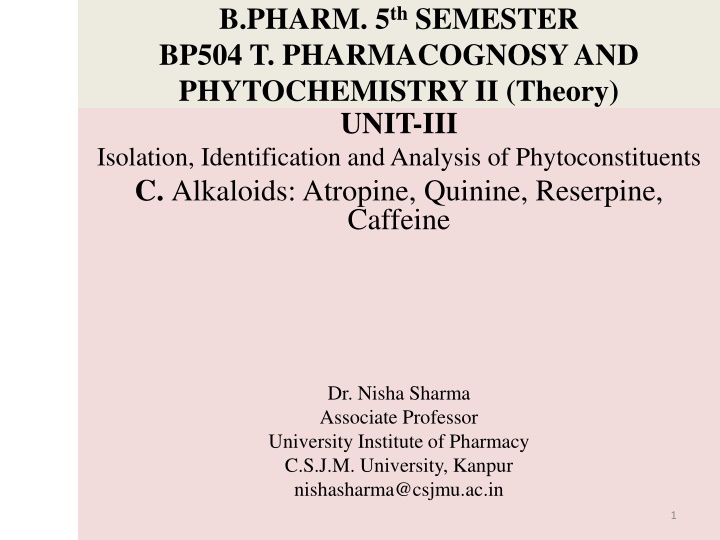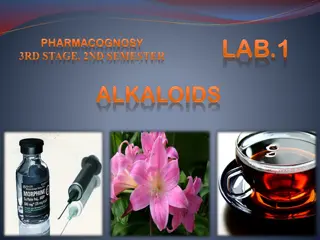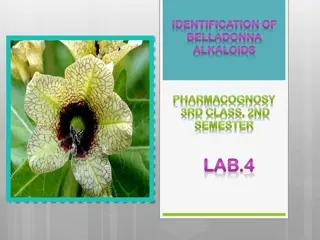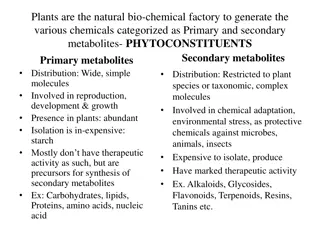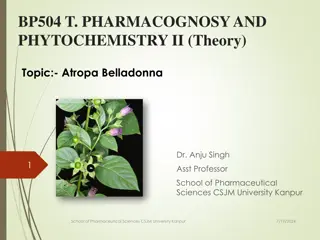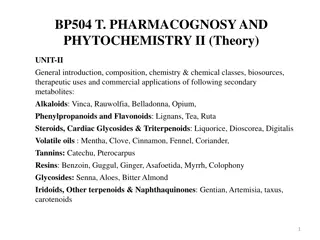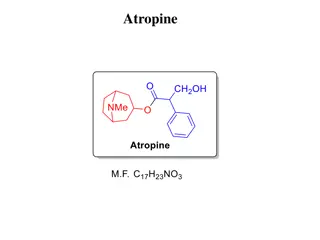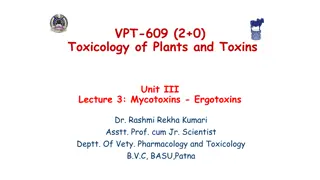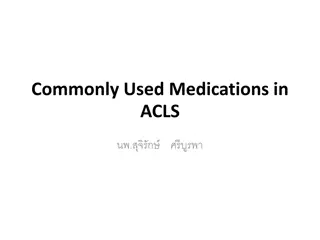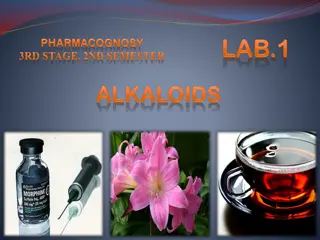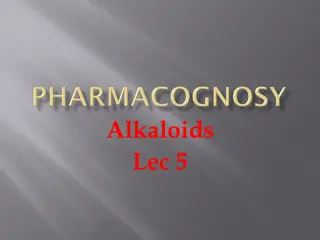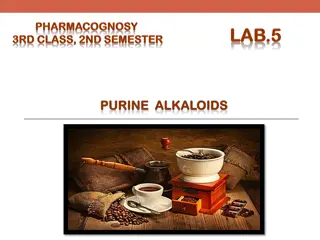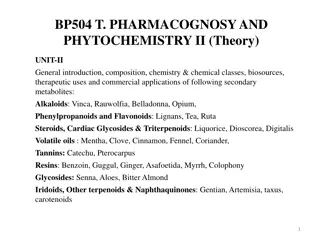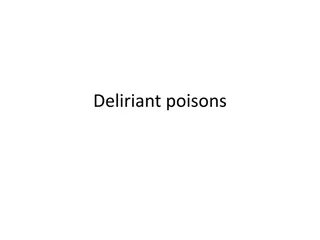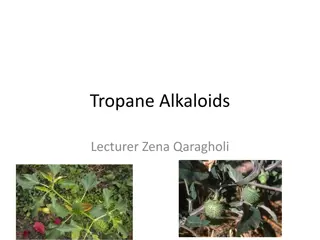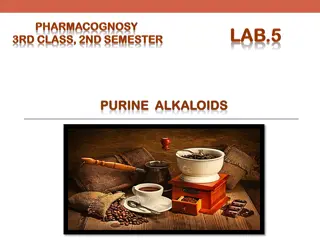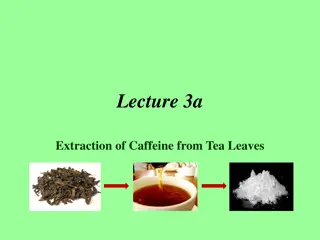Isolation and Analysis of Alkaloids: Atropine, Quinine, Reserpine, Caffeine
Alkaloids are extracted and isolated based on their basic character and solubility patterns using processes like Stas Otto. The general method includes treating plant material with solvents, extracting with ethanol, and separating bases using various techniques. Atropine, obtained from plants like Atropa belladonna, is isolated by extracting with petroleum ether, filtering, and recrystallizing to obtain pure crystals.
Download Presentation

Please find below an Image/Link to download the presentation.
The content on the website is provided AS IS for your information and personal use only. It may not be sold, licensed, or shared on other websites without obtaining consent from the author.If you encounter any issues during the download, it is possible that the publisher has removed the file from their server.
You are allowed to download the files provided on this website for personal or commercial use, subject to the condition that they are used lawfully. All files are the property of their respective owners.
The content on the website is provided AS IS for your information and personal use only. It may not be sold, licensed, or shared on other websites without obtaining consent from the author.
E N D
Presentation Transcript
B.PHARM. 5thSEMESTER BP504 T. PHARMACOGNOSY AND PHYTOCHEMISTRY II (Theory) UNIT-III Isolation, Identification and Analysis of Phytoconstituents C. Alkaloids: Atropine, Quinine, Reserpine, Caffeine Dr. Nisha Sharma Associate Professor University Institute of Pharmacy C.S.J.M. University, Kanpur nishasharma@csjmu.ac.in 1
ALKALOIDS Extraction and Isolation: The extraction of alkaloids is based on their basic character and solubility pattern. The normal procedures followed are to treat the moistened drug with alkali so as to set free the base as it exists in salts form and then separate free base with organic solvent. This is known as Stas Otto process.
ALKALOIDS General Method The plant material is powdered and treated with hexane or petroleum ether to separate fixed oils, fats and waxy substance, if any. Then extracted with boiling ethanol (hot extraction in soxhlet apparatus). Solvent is distilled off and residue is treated with inorganic acid, whereupon the bases are extracted as their soluble salts. The free bases are liberated by addition of sodium carbonate and extracted with organic solvents like chloroform. The mixture of bases thus obtained are separated by various methods into individual compounds like chromatography (Column chromatography, Thin layer chromatography, Gas chromatography etc.) for separation of vast number of alkaloids, steam distillation for volatile liquid alkaloids like coniine, sparteine, nicotine etc.
Atropine Biological source: Atropine is a tropane alkaloid obtained from the fresh or dried leaves and flowering tops of Atropa belladonna, Datura stramonium (Not less than 0.25%) and Hyoscyamus niger (Not less than 0.05%), belongs to family Solanaceae
Atropine Isolation: Required quantity of coarse powder is taken and moistens with sodium carbonate solution. The blended mixture is extracted in petroleum ether and filters it. To the filtrate aqueous acetic acid is added and further the aqueous fraction is extracted with ether. Both fraction are separated by separating funnel and discard solvent ether fraction. Aqueous (Acidic fraction) is made alkaline with sodium carbonate solution to obtain precipitates of tropane alkaloids.
Atropine Isolation: The precipitate is filtered and dry to obtain residue. The residue is dissolved in diethyl ether, filtered it and concentrated the filtrate. Atropine crystals will be separated out. The crystals are filtered and dissolve in alcohol containing sodium hydroxide solution (Hyocyamine is converted to atropine). The atropine sulphate is recrystallized from acetone and crystals of atropine are separated
Atropine Properties: Appearance: Colourless crystal or white crystalline powder with and. Odour: Odourless Taste: Bitter taste Solubility: Easily soluble in water, soluble in ethanol, but insoluble in ether and chloroform
Atropine Identification by chemical test: Vitali Morin test: Small quantity of the solid atropine is taken and added 2 drops of Conc. nitric acid in an evaporating dish and evaporated to dryness on water bath. Then the residue is dissolved in 1ml of acetone and few drops of freshly prepared alcoholic potassium hydroxide solution is added. Violet coloration takes place due to tropane nucleus
Atropine Analysis by TLC Sample preparation : 1mg of Atropine is dissolved in 1ml of chloroform Standard sample : Atropine Stationary phase : Pre-coated Silica gel Mobile phase : Toluene: Ethyl acetate: Diethyl amine (70:20:10) Detecting agent : Dragendorff s reagent RF Value : 0.70 Color spot : Yellow orange spot Utilization: It is used as antispasmodic, mydriatic and antidote in opium poisoning. Storage condition: It should be store in well closed and air-tight containers protected from light and in cool place.
Quinine Cinchona calisaya (Peruvian)
Quinine Biological source: Quinine is a quinoline alkaloid obtained from the dried bark of Cinchona calisaya, Cinchona officinalis, Cinchona ledgeriana and Cinchona succirubra, belongs to family Rubiaceae. Quinine and quinidine are stereo-isomers. Quinine is levorotatory and quinidine is dextrorotatory.
Isolation:Quinine Required quantity of dry powder bark material is first well mixed with about 30% of its weight of alcoholic calcium hydroxide or calcium oxide or calcium oxide (20%) and sufficient quantity of sodium hydroxide solution (5%) to make a paste. It is allowed to stand for few hours so that alkali can convert cinchona alkaloids to free bases. The mass is then transferred to a Soxhlet apparatus and extraction is carried out with benzene for 6 hours. After competition of extraction the benzene extract is shaken with successive portions of 5% sulphuric acid in separating funnel. The aqueous acid extract is separated from benzene layer and adjusted the pH 6.5 with dilute sodium hydroxide, cooled. Crystals of quinine sulphate are formed, filtered and recrystallized with hot water
Quinine Properties: Appearance: Colourless crystal or white crystalline powder Odour: Odourless Taste: Intensely bitter taste Solubility: Sparingly soluble in water, readily soluble in chloroform, alcohol and ether Identification by chemical test: Thalleoquin test: Bromine water and ammonia solution is added in small quantity of powdered the sample. Emerald green colour takes place which indicates the presence of quinine
Quinine Analysis by TLC Sample preparation: 1mg of Quinine is dissolved in 1ml of methanol Standard sample: Quinine Stationary phase: Silica gel-G Mobile phase: Chloroform: Diethyl amine (9:1) Detecting agent: Dragendorff s reagent RF Value: 0.17
Analysis by HPLC Method : Isocratic Stationary phase : C18 Column Mobile phase :Methanol: Acetonitrle-0.1mol/L: ammonia: acetone (45:15:40) Detection : Fluorescence at excitation 325nm. Emission : 375nm [5] Utilization: Quinine is antimalarial. Quinidine is a cardiac depressant therefore used in cardiac arrhythmias. Storage condition: It should be store in well closed and air-tight containers protected from light and in cool place.
Reserpine Biological source: Reserpine is an indole alkaloid obtained from the dried roots of Atropa belladonna, Rauwolfia serpentina, belongs to family Apocynaceae. Sarpagandha contains not less than 0.15% of reserpine and ajmalcine
Isolation: Rauwolfia root powder is exhaustively extracted with 90% alcohol in Soxhlet apparatus. The alcoholic extract is filtered, concentrated and dried under reduced pressure below 60 C to yield dry extract. The dry extract is extracted with ether- chloroform- 90% alcohol (20:8:2.5) and filtered. In filtrate dilute ammonia is added with intermittent shaking. Then water is added to precipitate the crude alkaloids mixture and allowed the drug to settle after vigorous shaking.
Isolation: The solution is filtered off and extracted the residue with 4 volumes of 0.5N Ammonium sulphate in separating funnel and combined all the extracts. The extract is made alkaline with dilute ammonia to liberate alkaloid. Finally it is extracted with 3 portion of chloroform. Chloroform extract is collected, concentrated and evaporated on water bath to yield total rauwolfia alkaloids. Residue is subjected to column chromatographic fraction for the separation of reserpine
Reserpine Properties: Appearance: White or pale buff to slightly yellow crystalline powder, darkening slowly on exposure to light. Odor: Odourless Taste: Bitter taste Solubility: Soluble in alcohol, chloroform and acetone, partially soluble in water, freely soluble in acetic acid
Reserpine Identification by chemical test: When sample is treated with solution of vanillin in acetic acid, a violet red colour is produced which indicates the presence of reserpine Analysis by TLC Sample preparation : 1mg of Reserpine is dissolved in 1ml of methanol Standard sample : Reserpine Stationary phase : Silica gel-G Mobile phase : Chloroform: Acetone: Diethyl ether (50:40:10) Detecting agent : Dragendorff s reagent RF Value : 0.72-0.35 Color spot : Orange spot
Reserpine Utilization: It is used as antihypertensive and antipsychotic agent Storage condition: It should be store in well closed and air-tight containers protected from light and in cool place.
Caffeine Thea sinensis (Tea leaves)
Caffeine Biological source: Caffeine is a purine alkaloid obtained from Tea leaves, Coffee seeds, cocoa, and other species. It is chemically 1, 3, 7, trimethyl xanthine which is isolated from tea and coffee seeds during decaffeination process It is obtained from the prepared leaves and leaf buds of Thea sinensis, belongs to family Theaceae and dried ripe seeds of Coffea Arabica, C. liberica, belongs to family Rubiceae. Tea leaves contains 1-4% of caffeine and coffee contains 1- 2% of caffeine.
Isolation: Caffeine The powder tea leaves is extracted with boiling water and the aqueous extract is filtered while hot. The warm extract is treated with lead acetate to precipitate tannins and filtered. The filtrate is treated with excess of dilute sulphuric acid to precipitate lead in the form of lead sulphate. The filtrate is boiled with activated charcoal to remove colouring matter, if any and filtered to remove charcoal. The filtered decolourized solution is extracted with chloroform successively. Combined the chloroform extracts and evaporated on water bath to yield caffeine (white powder). It is recrystallized with alcohol
Caffeine Properties: Appearance : White powder or white glistering needles Odor : Odourless Solubility : Soluble in hot water Identification by chemical test: Murexide test: Sample is taken in a petridish to which hydrochloric acid and potassium chlorate are added and heated to dryness. A purple color is obtained by exposing the residue to vapors of dilute ammonia. The purple color is lost on addition of fixed alkali Taste : Bitter taste
Caffeine Analysis by TLC Sample preparation : 1mg of Caffeine is dissolved in 1ml of methanol or chloroform Standard sample : Caffeine Stationary phase : Silica gel-G Mobile phase : Ethyl acetate: methanol: acetic acid (80:10:10) Detecting agent : Expose to vapors of iodine RF Value : 0.41 Color spot : Brown spot [4, 5] Analysis by HPLC Method : Isocratic Stationary phase : C18 column Mobile phase : Methanol: Water (25:75) Detection : UV-Visible detection 254nm
Caffeine Utilization: Caffeine is a CNS stimulant and Diuretic. It is used in beverage. Storage condition: It should be store in well closed and air-tight containers protected from light and in cool place.
References Lecture notes by Mr. Ashutosh Meher, Associate professor, Barpali, Bargarh, Odisha 28
